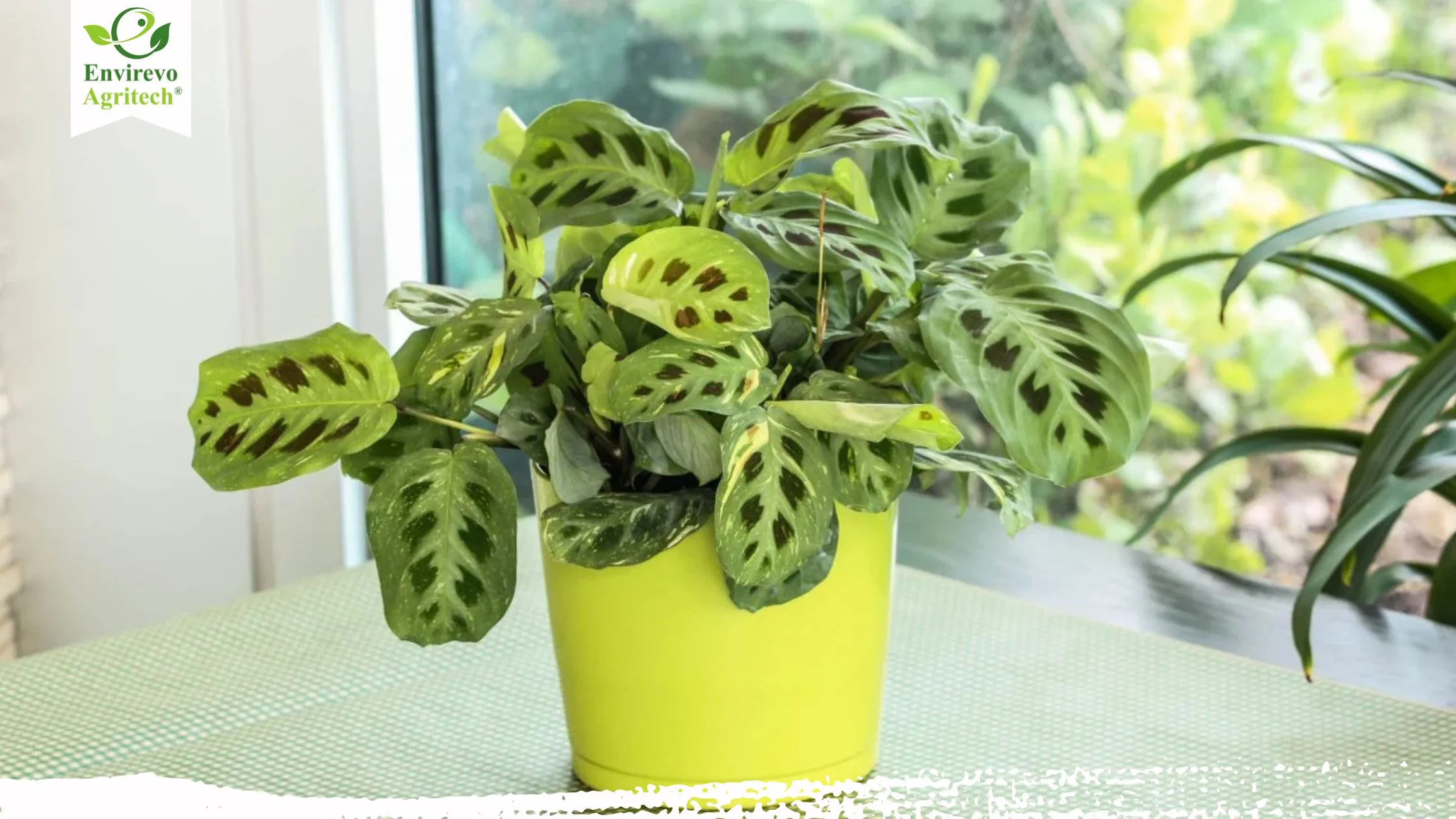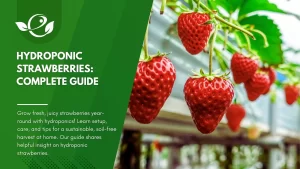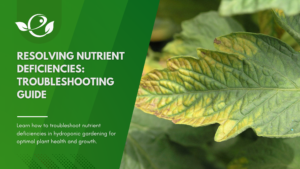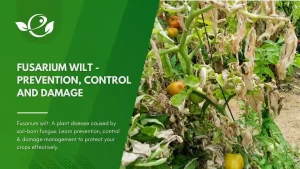Table of Contents
Strikingly beautiful and full of personality, the prayer plant (Maranta leuconeura) has become a favorite among indoor plant lovers. With its vibrant foliage and fascinating nightly leaf movements, it’s more than just decor—it’s a living, dynamic piece of nature.
But while it’s an attention-grabber, it’s also a bit of a diva. Proper prayer plant care is essential if you want to keep those patterned leaves perky and healthy. In this complete growing guide, we’ll walk you through everything you need to know—from light and water needs to pruning, propagation, and pest control.
What Is a Prayer Plant?
The prayer plant, scientifically known as Maranta leuconeura, is a low-growing tropical plant native to the rainforests of Brazil. It belongs to the Marantaceae family, and it’s named for its habit of folding its leaves at night, like praying hands—a phenomenon known as nyctinasty.
These plants are known for their lush, oval-shaped leaves adorned with eye-catching patterns in green, red, purple, and yellow hues.
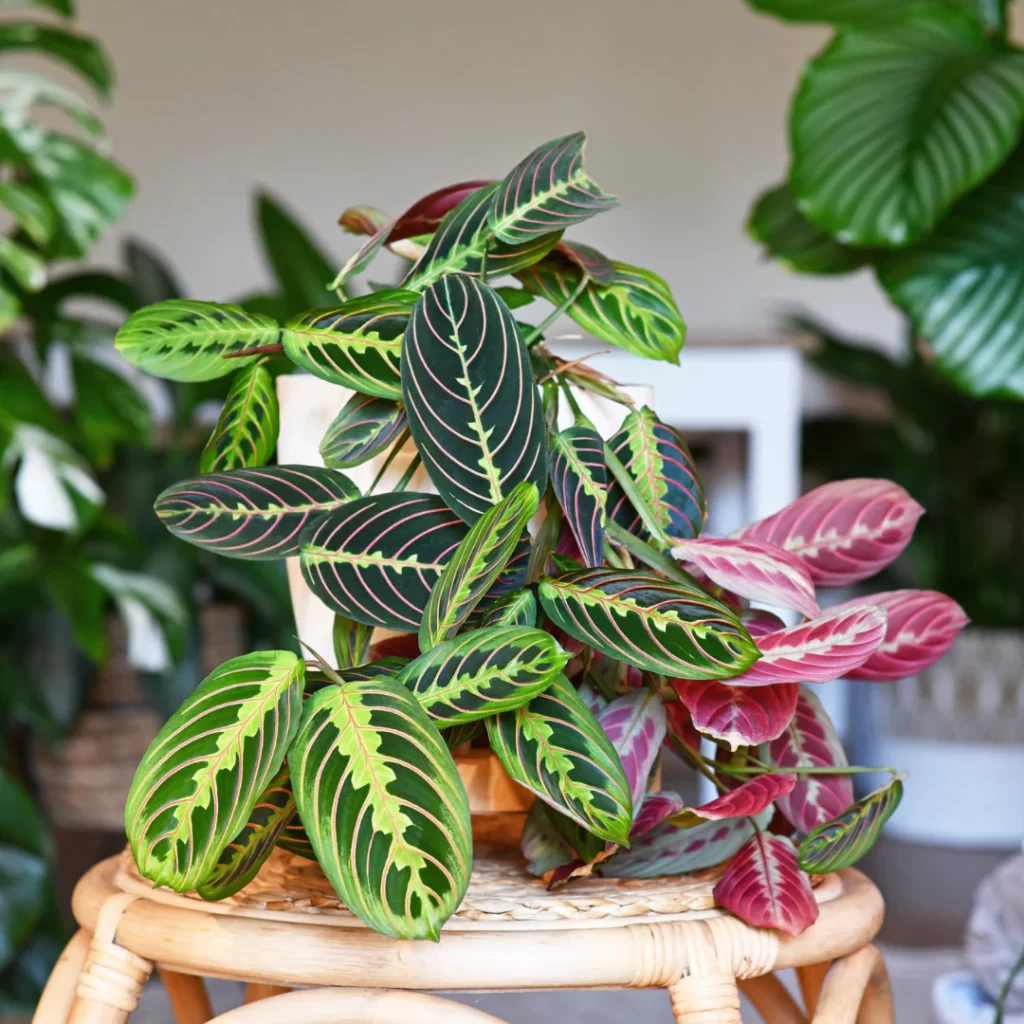
| Attribute | Details |
|---|---|
| Common Name | Prayer Plant |
| Botanical Name | Maranta leuconeura |
| Plant Type | Tropical, Perennial, Houseplant |
| Family | Marantaceae |
| Native Region | Brazil (Central and South American Tropics) |
| Hardiness Zones | USDA Zones 11–12 (outdoor); best indoors |
| Mature Size | 6–12 inches tall; 12–18 inches wide |
| Light Requirement | Bright, indirect sunlight |
| Watering Needs | Moderate; keep soil evenly moist |
| Humidity Needs | High (50% or more preferred) |
| Soil Type | Well-draining, peat-based potting mix |
| Pet Safety | Non-toxic to cats and dogs |
Benefits of Having a Prayer Plant
- Air-Purifying Qualities: Prayer plants help clean the indoor air by removing toxins, improving air quality in your home or office.
- Eye-Catching Foliage: Their vibrant, patterned leaves in shades of green, red, and purple make them excellent decorative plants for any space.
- Non-Toxic to Pets: Safe for households with cats and dogs—no worries about accidental ingestion.
- Fascinating Leaf Movement: The plant folds its leaves upward at night (nyctinasty), adding a unique, interactive element to your indoor garden.
- Low Maintenance (Once Established): With consistent care, prayer plants are relatively easy to maintain and can thrive for years.
- Thrives in Humid Environments: Perfect for bathrooms or kitchens where humidity levels are naturally higher.
- Easy to Propagate: You can create new plants from cuttings, making it an affordable and shareable option for plant lovers.
- Mood-Boosting Decor: Studies show that indoor plants can reduce stress and boost mood—prayer plants, with their lively nature, are no exception.
Popular Prayer Plant Varieties
1. Maranta leuconeura ‘Erythroneura’
- Also known as the Red Prayer Plant, this is the most common variety.
- Deep green leaves with striking red veins and a light green midrib
2. Maranta leuconeura ‘Kerchoveana’
- Commonly called Green Prayer Plant or Rabbit Tracks.
- Light green leaves with dark green blotches
3. Maranta leuconeura ‘Massangeana’
- A rare and more dramatic variety with a luxurious touch.
- Dark green to purplish leaves with silver or gray veins
4. Maranta leuconeura ‘Lemon Lime’
- A vibrant cultivar gaining popularity for its neon details.
- Bright green leaves with lime-colored veins and soft yellow markings
5. Maranta leuconeura ‘Kim’
- A lesser-known hybrid, great for collectors.
- Subtle green variegation with patterned lines

Ideal Growing Conditions for Prayer Plants (Prayer Plant Care)
Creating a home environment that mimics the prayer plant’s tropical origins is key to success. Here’s what your Maranta needs:
☀️ Light Requirements
Prayer plants thrive in bright, indirect light. Too much direct sun will bleach or scorch the leaves, while too little light can cause dull coloration and leggy growth.
Pro Tip: East-facing windows are ideal. If light is too low, consider using a grow light to supplement.
🌡️ Temperature & Humidity
- Temperature: 65–80°F (18–27°C) is optimal. Avoid cold drafts or sudden drops below 60°F.
- Humidity: Prayer plants love high humidity. Aim for 50% or higher.
Ways to increase humidity:
- Use a humidifier
- Group with other plants
- Place on a pebble tray with water
🌱 Soil Type
Use a well-draining potting mix that retains moisture but doesn’t stay soggy. A good blend:
- 2 parts peat moss or coco coir
- 1 part perlite or orchid bark
- 1 part potting soil
The soil should be slightly acidic (pH 5.5–6.0).
💧 Watering Schedule
Prayer plants are sensitive to water quality and moisture levels.
- Water when the top 1 inch of soil is dry.
- Use filtered or distilled water at room temperature.
- Avoid letting the soil dry out completely, but don’t let it stay soggy either.
Signs of watering issues:
- Brown tips: low humidity or inconsistent watering
- Yellowing leaves: overwatering
- Crispy edges: fluoride or salts in tap water
🌼 Fertilizer Needs
Prayer plants benefit from regular feeding during the growing season (spring to early fall).
- Use a balanced, water-soluble fertilizer (e.g., 10-10-10 or 20-20-20).
- Dilute to half-strength and apply every 4 weeks.
- Stop fertilizing in winter.
Avoid over-fertilizing, as it can cause leaf burn and salt buildup in the soil.
Prayer Plant Interactive Simulation
What makes Prayer Plants fold their leaves at night?
Prayer plants (Maranta leuconeura) are known for their fascinating nyctinasty – the daily movement of leaves that fold upward at night like hands in prayer. This simulation lets you explore how environmental factors affect this behavior and overall plant health.
Adjust the sliders below to see how different conditions affect your virtual Prayer Plant!
Your Virtual Prayer Plant
Environmental Controls
Plant Health Indicators
This chart shows how current environmental conditions affect your plant’s overall health. Prayer plants thrive with:
- Bright, indirect light (avoid direct sun)
- Consistently moist (not soggy) soil
- High humidity (50-60% or higher)
- Temperatures between 65-80°F
Leaf Movement Analysis
Prayer plants fold their leaves upward at night (nyctinasty) and lower them during the day. This movement is affected by:
- Light cycles (primary trigger)
- Plant health (stressed plants show reduced movement)
- Temperature (extreme temperatures reduce movement)
- Water status (dehydrated plants have limited movement)
Growth Rate Projection
This chart projects growth patterns based on current conditions. Prayer plants:
- Grow most actively during spring and summer
- Slow or stop growth when conditions are poor
- Produce new leaves approximately every 3-4 weeks when healthy
- May become leggy with insufficient light
Pruning Prayer Plant: Why and How
Pruning your Prayer Plant isn’t just about aesthetics—it promotes healthy growth and keeps your plant looking full and vibrant. Prayer plants benefit from occasional pruning to maintain a tidy shape and encourage bushier growth, as their natural creeping habit can lead to long, unruly stems in pots.
✅ Benefits of Pruning
- Encourages bushier, compact growth
- Removes leggy or damaged stems
- Improves air circulation around the plant
- Keeps your plant looking neat and tidy
🛠️ How to Prune a Prayer Plant
- Use clean, sharp scissors or pruning shears.
- Cut just above a leaf node (the small bump where leaves emerge).
- Trim away any yellowing, dead, or leggy stems.
- You can also pinch back the tips with your fingers to promote branching.
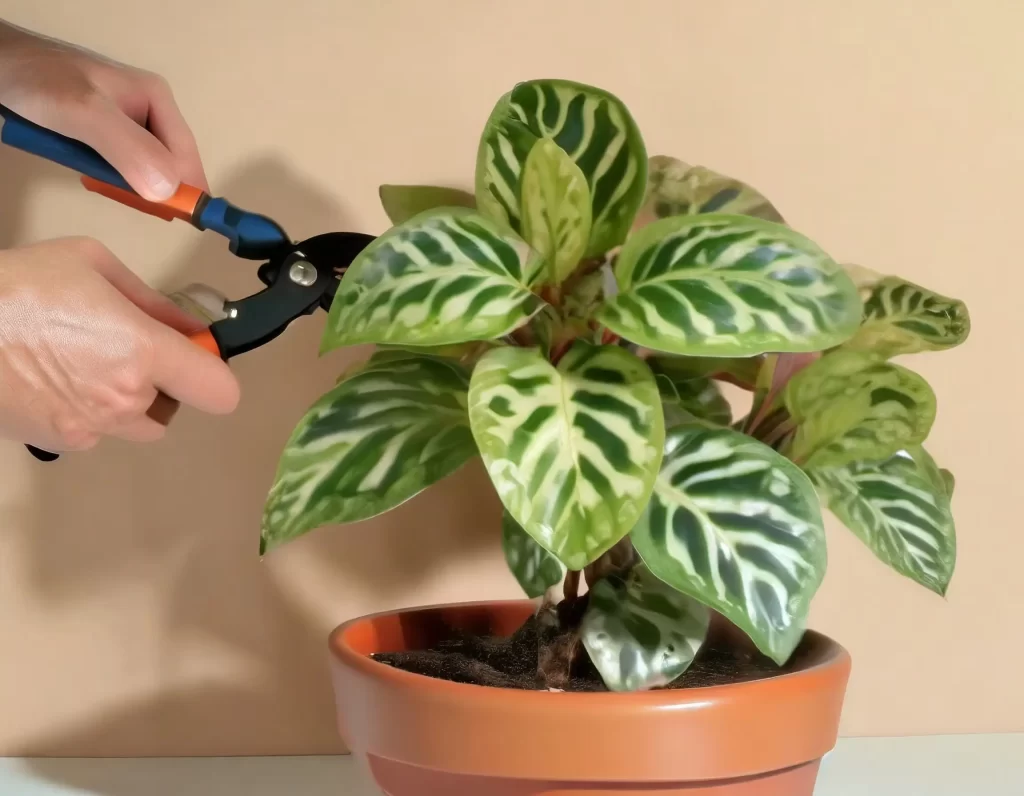
🔄 Tip: Pruning is best done in spring or early summer, during the plant’s active growing season.
Potting and Repotting Prayer Plant
Proper potting is essential for the health and growth of your Prayer Plant (Maranta leuconeura). Though it doesn’t need frequent repotting, checking the roots annually helps keep the plant thriving.
🏺 When to Repot
- Every 1–2 years, ideally in spring or early summer
- When roots start circling the bottom or pushing out of the drainage holes
- If growth slows down or the plant becomes root-bound
🌿 How to Repot a Prayer Plant
- Select a pot 1–2 inches wider than the current one, with good drainage.
- Use a well-draining, peat-based potting mix (or mix peat moss, perlite, and compost).
- Gently remove the plant and loosen the roots without damaging them.
- Replant it at the same depth in the new container and water thoroughly.
- Keep it in a warm, humid spot with indirect light after repotting.
💡 Tip: Prayer plants are sensitive to shock—be gentle and avoid repotting too often.
Propagating Prayer Plant: Easy Step-by-Step Guide
Propagating your Prayer Plant is a rewarding way to expand your indoor garden or share plants with friends.
- Method: Stem cuttings in water or soil.
- Step 1: Choose a healthy stem with at least 2-3 leaves.
- Step 2: Cut just below a node (where leaves attach to the stem).
- Step 3: Place the cutting in a glass of water or directly into moist potting soil.
- Step 4: Keep in bright, indirect light and maintain high humidity.
- Step 5: Roots should develop within 2-4 weeks. Once roots are about 2 inches long, transplant into a pot with well-draining soil.
💧 Tip: Change the water every few days if propagating in water to prevent stagnation.
Common Prayer Plant Problems (and How to Fix Them)
| Problem | Cause | Solution |
|---|---|---|
| Yellow Leaves | Overwatering, poor drainage, root rot | Reduce watering, improve drainage, repot if needed |
| Brown Leaf Tips | Low humidity, inconsistent watering, fluoride in water | Increase humidity, use distilled water, water evenly |
| Dropping Leaves | Low humidity, inconsistent watering, and fluoride in water | Keep stable temperature, avoid drafts, adjust watering |
| Curling Leaves | Low humidity, underwatering | Raise humidity, water consistently |
| Leaf Spots | Fungal or bacterial infection, too much moisture | Remove affected leaves, improve air circulation, avoid overhead watering |
| Leggy Growth | Insufficient light | Move to brighter indirect light |
Common Pests
| Pest | Symptoms on Prayer Plant | Control Methods |
|---|---|---|
| Spider Mites | Tiny webbing, speckled yellow or brown leaves | Increase humidity, wash leaves, use insecticidal soap or neem oil |
| Mealybugs | White cottony masses on stems and leaves | Wipe off with alcohol-soaked cotton swab, apply neem oil or insecticidal soap |
| Aphids | Sticky residue (honeydew), curled or distorted leaves | Spray with water, use insecticidal soap or neem oil |
| Scale Insects | Small, brown, shell-like bumps on stems/leaves | Remove manually, apply horticultural oil or neem oil |
| Fungus Gnats | Tiny flying insects around soil surface | Let soil dry between watering, use sticky traps, beneficial nematodes |
Display & Styling Tips
Prayer plants shine as indoor décor due to their vibrant colors and trailing habit.
- Hang in a macrame planter for a boho touch.
- Place on a shelf with trailing vines hanging down.
- Pair with other tropicals like calatheas or ferns for a lush jungle vibe.
- Use decorative pots in earthy tones to highlight the foliage.
| Category | Details |
|---|---|
| Light | Bright, indirect sunlight |
| Water | Keep soil moist, not soggy |
| Humidity | High (50% or more) |
| Soil | Well-draining, peat-based mix |
| Temperature | 65–80°F (18–27°C) |
| Fertilizer | Monthly during growing season |
| Toxicity | Non-toxic to pets and humans |
FAQs
Why are my prayer plant’s leaves not folding at night?
This could be due to insufficient light or stress. Ensure it gets bright, indirect light and high humidity.
Can I grow a prayer plant in a bathroom?
Yes! Bathrooms are great due to the higher humidity—just ensure it gets natural or artificial light.
My prayer plant is turning yellow. What should I do?
Check for overwatering or root rot. Ensure proper drainage and adjust watering frequency.
How fast do prayer plants grow?
Growth is moderate. With ideal care, expect new leaves every few weeks during spring and summer.
Is the prayer plant safe for pets?
Yes, it’s non-toxic to cats and dogs, making it a great pet-friendly houseplant.
Final Thoughts
With the right care routine, a prayer plant can be a long-lasting, showstopping houseplant. Its dramatic foliage and nightly rituals offer beauty and a touch of magic to any space.
Remember: consistent watering, high humidity, and indirect light are the pillars of successful prayer plant care. Once you’ve got those down, your Maranta will reward you with lush, colorful leaves and mesmerizing movements.
